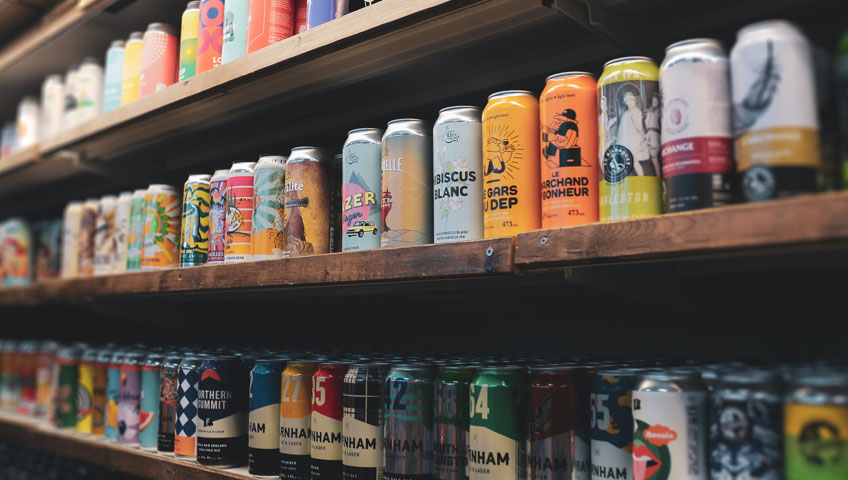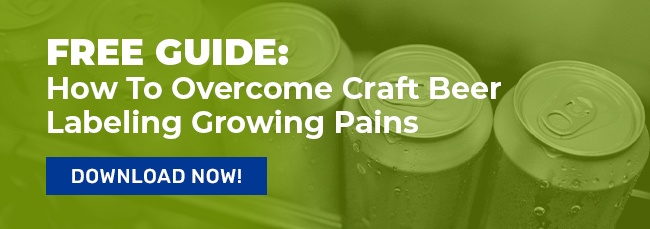
Complete Guide to Craft Beer Can Wrap Labeling–Shrink Sleeve vs. Pressure-Sensitive
The market for canned craft beer has exploded in the past few years, thanks to more cost-effective production and life cycle, as well as sustainability and reduced environmental impact. But, if you’re switching to can production, you need to make several choices regarding new product labels.
Are pressure-sensitive can wraps or shrink sleeve can wraps a better fit for your production system and your marketing? What features should you look for in a can label? How does a can labeling system fit into your production system?
Here’s what you need to know, so you can make an informed decision about your labeling needs.
Why Should I Consider Canning My Craft Beer?
Cans are lighter and less prone to failure than glass bottles. This saves money and lowers your business’ ecological footprint. In fact, switching from glass bottles can cut your transportation and refrigeration emissions by 35-50%.
Why Wrap Cans Instead of Printing Them?
When printing directly on cans, most printing companies require a minimum order of one truckload, which is typically 150,000 cans. For small craft breweries, this one order could be more than your entire output for the year. (And, even if you have a large operation, you probably have some seasonal product lines that sell in much smaller numbers than this minimum order.)
But, good news–numerous craft brewers are switching to cans nowadays, thanks to new labeling technology. Unlabeled cans, called “brites,” are available by the pallet, and labels can be purchased by the reel, which lets brewers purchase small, manageable orders. It also simplifies storage, since you can have a few pallets of reels to go with your can inventory, instead of storing cans for every line you offer.
Can wraps offer maximum shelf appeal for your product while providing a more flexible packaging inventory scenario.
Pressure-Sensitive Labels vs. Shrink Sleeve Labels
There are two choices for the label application process for your cans: pressure-sensitive labeling and shrink sleeve labeling. Each method of craft beer labeling has its advantages and disadvantages.
Pressure-Sensitive Labeling for Beer Cans
Pressure-sensitive labels wrap around the flat surface of the entire container. On cans, that means they cover most of the can, leaving the base and lip untouched. These adhesive labels stick to the can on contact. Application equipment is simple, and it’s easy to add information during label application with a print engine.
Pressure-sensitive labels cost a little more than the cut and stack cold glue labels used on some bottles. However, if you already use pressure-sensitive labels on your bottles, you’ll find little difference in labeling costs when you switch to cans.
Shrink Sleeve Labeling for Beer Cans
When shrink sleeves are heated, they form around the entire side of the can, including the curved areas. This gives you more real estate to add graphics and information to the label design.
This option also utilizes the container shape for 360 degree design. Plus, the printing is on the inside of the sleeve, so it’s harder to damage via abrasion.
However, the label printing, materials and complicated labeling system required for shrink sleeve application makes it more expensive than pressure sensitive labeling. Unless you have a large operation, many small brewers find that they need to outsource shrink wrap labeling, which complicates logistics. (Expect to spend at least 25% more on a shrink sleeve label than a pressure sensitive label.)
Cans have to survive in warm, cold and moist environments, including trucks, refrigerator cases, cars and ice-filled coolers. Shrink sleeves are plastic, and they don’t use adhesive, so they aren’t affected by moisture. However, moisture can be a problem for pressure sensitive labels, both during packaging and throughout the life cycle of the product. Condensation created after filling can keep some adhesives from setting. (This can be avoided by using a “wet” adhesive, or by wiping off the cans with an air knife shortly before processing. And, condensation issues during the product life cycle can be avoided by choosing water-resistant labels.)
Since shrink sleeves aren’t bonded to cans, they can peel off during transit, and they can warp when exposed to extreme temperatures. To limit the heating of the beer during application, beer can sleeves must be pre-shaped to something close to the container size before application. This adds complexity and cost. A pressure sensitive label, by comparison, is much harder to damage.
Keep in mind that it’s all but impossible to print directly onto shrink sleeves, so any container-specific information has to be applied to the bottom of the can using a high-speed printer. With pressure-sensitive labels though, information can be printed directly on the label during application. This is especially handy if you want to add a “best by” date to the can.
As for appearance, each design has its advantages. Shrink sleeve can wraps offer the widest coverage, so you have more space to add information. However, pressure-sensitive can wraps are available with a wide range of full-color options and finishes, helping your beer stand out on the shelf.
Recyclability May be Affected by Label Material
Aluminum cans are a great choice if you want more of your containers to be recycled. While most curbside recycling programs won’t pick up glass, virtually every program accepts aluminum cans. However, the labeling you choose can be an issue
Both shrink sleeves and labels burn off cans when they’re melted down. Currently, this isn’t a problem because these cans make up a small percentage of the total waste stream. However, the residue shrink sleeves leave behind is hard on equipment, and they may be mistaken for plastic bottles during sorting. Vinyl labels have similar problems, but on a smaller scale. Paper labels burn cleaner, but the fire they produce can still damage equipment. If their use increases, we could see recyclers refuse to take labeled cans, or apply an upcharge for waste streams that include these cans.
Shrink sleeves are easy to remove, but they almost always end up in the trash. PVC sleeves can’t be recycled anywhere. PETC sleeves can be recycled, but most recycling programs can’t take them. Treated paper labels can be recycled, but waterproof vinyl labels cannot. If you want to minimize your product’s environmental impact, you need to pair your recyclable labels with adhesives that allow the label to be removed by the end user.
What Does an Effective Craft Brewing Labeling Solution Look Like?
If you want to see what a can wrap system can do for your production system, check out our video with Birdfish Brewing Company. We worked with them to create a new labeling solution for their products that addresses their production problems and speeds up application.
If you need a flexible can labeling solution, consider our 360a WR Wrap System. This machine can apply labels to a range of round containers, and it can switch between several pre-calibrated label configurations. This lets you use one machine for several sizes of cans, from standard 12 ounce containers to crowlers.
In most craft breweries, space is at a premium. That’s why we design our labeling equipment for compactness and compatibility with our adjustable bases. Our H-base stand has a low profile base, so it can slide under conveyors and other equipment. It uses an internally-routed lift system that has both fast and fine adjustments. This makes it easy to line up your labeling machine with your production line’s conveyor belts. At CTM Labeling, we offer this stand with stainless steel components, so you don’t need to worry about contamination from paint or rust.
We Can Help You Make the Switch to Cans
If you’re looking for a reliable, efficient system for printing and applying high quality labels to your craft beer cans, talk to CTM Labeling Systems. We have local distributors that can work with you, creating a labeling system that fits your new packaging system and improves upon your current labeling process.





